|
CHAPTER XV.
PLYMOUTH, OHIO.
Pg. 426
Offshoot of Its Namesake in Connecticut and the First Episcopal Parish
in the State of Ohio - Descendants of These Early Settlers,
Numbering Four Hundred or More, Organize Themselves as the "Mann,
Blakeslee and Seymour Re-union Association."
A GLANCE at the man of Ohio, will convince
any one, that the early settlers of that state were an unusually
loyal, patriotic body of men. The larger number of counties
are named directly after the heroes of the Revolution, in grateful
remembrances of their noble self-sacrificing labors. The first
settlement in Ohio was named Washington, and the county seat called
Mariette, in honor of Marie Antoinette, the beautiful Queen
of France. Among the prominent counties are Jefferson,
Madison, Hamilton, Fayette, Carroll, Hancock, Jackson, Greene, Knox,
Lawrence, Wayne, Starke, Adams, Warren, Henry, and others, all names
recorded in history, and held in sincere regard by every lover of
his country.
The Western Reserve, comprising about 325,000,000
acres, was sold by the State of Connecticut, to a syndicate of her
sons, for a sum about equal to the cost of building the viaduct
across the Cuyahoga River at Cleveland. The early settlers of
New Connecticut, as the Reserve was called, were nearly all New
England men and women, bred to labor, economical, frugal,
industrious, patient, intelligent, God fearing, believing in
schools, college, churches, and liberty protected by law. The
growth of the Reserve was slow, until after the war 1812, when it
became the homes of tens of thousands of emigrants. The
character of the early settlers gave promise of a secure future of
the new colony, which time has fully redeemed. It is probably
true, beyond question, that at this moment, the Western Reserve, for
its extent and population, it not surpassed in any country, for the
thrift, general prosperity, public and private morality, and high
standard of education of its people. In 1806, the Reserve
contained about six thousand souls, and was divided into two
counties. In 1895, it had ten counties, and nearly a million
inhabitants.
In 1811-12, several families went from Plymouth, Conn.,
and settled in South Ashtabula. The name of the township was
soon after changed to Plymouth, in compliance with the wises of the
original settlers. Nearly all the early emigrants were
Episcopalians, and their first worship was by lay-reading, led by
Zadoc Mann, who presided, until the arrival of Rev. Roger
Searle, their former minister in Plymouth, who held service in
the house of Hal Smith first, on Feb. 19, 1817,and
immediately followed the organization of "The Parish of St. Peter's
Church, Ashtabula." the first Episcopal denomination in the State of
Ohio. Mr. Searle named the parish after the one he had
formerly presided over in Plymouth.
As near as can be learned, at this late date, the
families that went from Plymouth, Conn., were those of Zadoc
Mann, Warner Mann, John Blakeslee, Asher Blakeslee, Lynus Hall,
Titus Seymour, Dr. David Warner and Elias Cook Upson.
There were, doubtless, others.
Originally, Plymouth Township was included in the
limits of Ashtabula, and it was not until Jan. 7, 1838, that the
territory was, by order of the County Commissioners, detached from
that township, and created a new one, to be known as Township No.
12, of the third range.
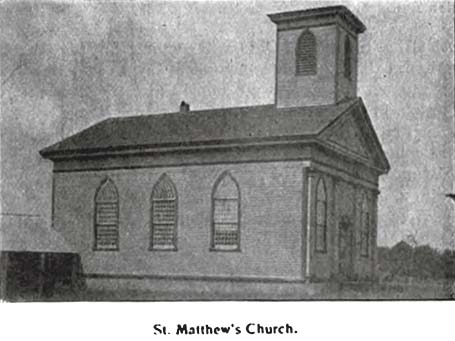
On July 4, 1838, the township was regularly organized
and these officers elected: Samuel Burnet, Andrew Wiley, and
William Stewart, trustees; Levi P. Blakeslee, township
clerk; Bennett Seymour, treasurer; Elias Cook Upson
and William Foster, overseers of poor; Joseph Mann, James
Hall and Solomon A. Simons, Elias C. Upson and Merritt
M. Mann, supervisors. The first Justice of the Peace, was
Warner Mann who was elected on the 9th day of November, 1838,
his commission bearing date Nov. 26, 1838. This election was
held at the house of the justice elect. Warner Mann was
succeeded by Josiah Allen, and he, by Wells Blakeslee.
Previous to the expiration of Warner Mann's commission,
however, a second justice was ordered for the township, and
Daniel Hubbard was the first to fill the office. Levi
P. Blakeslee succeeded him, and was in turn succeeded by
Samuel Burnet.
The township was originally owned by Nehemiah
Hubbard, of Middletown, Middlesex County, Conn., Hon. Matthew
Hubbard, who located in Ashtabula in 1804, being agent for the
proprietor.
The first settlement, within the present limits of the
township, were as follows: In 1804 or 1805, Wm. Thompson
and Thomas McGahhe, with their family, located on lot
number five. In the spring of 1806, Samuel White began
improvements on two hundred acres, upon the north line of the
township. Fitz's woolen factory was subsequently
established on this lot, which was later owned by Ezra Bunnell.
David Burnet settled on lot number twelve, also in the spring of
1806. This lot was afterwards owned by Wells Blakeslee;
then Oliver Gary became occupant. Both White and
Burnet came from Hubbard, Trumbull County. in 1807,
Thomas Gordon purchased two hundred and forty acres, in lot
number six, and in the spring of 808, took possession of the same
with his family. William Foster, of Sacket's Harbor,
New York, arrived in the township in 1810, locating on lot number
ten. His mode of transit was by a small boat to Ashtabula; at
Niagara Falls, he hired a team to haul his boat some seven miles
around the falls. Captain Moses Hall emigrated from
Connecticut in 1811, and began the life of a pioneer on the
northwest corner lot.
The first log house was erected in 1804 or 1805, on lot
number five, by William Thompson, the oldest inhabitant, who
removed from the township in1807. The First orchard was
planted by Samuel White, in the spring of 1807. It was
located on his farm, near the pond, and consisted of forty trees.
They first bore fruit in 1811, which was, without doubt, the first
produced within the territory composing the townships of Plymouth
and Ashtabula. Capt. Moses Hall was the owner of the
orchard at this time, and it is said he distributed nearly the
entire yield of the orchard, among the sick of the township.
Upon the first settlement of the Plymouth pioneers, the
only road was the "girdled" one, laid out by the Connecticut Land
Company, running form Kelloggsville, via Sheffield, through Plymouth
and west through Saybrook, Austinburg, etc., terminating at or near
Cleveland. The first road road authorized by the county
commissiones, after Plymouth became a separate township, was in
June, 1842, which began on the Jefferson and Ashtabula road, at
William Willard's northeast corner, thence east on lot lines to
Denmark road. March, 1844, another road was surveyed, running
from William Stewart's, northeast and north, to the road
south of Amos Moses, in Kingsville. March, 1850, the
last one was established from the southwest corner of the township,
north to the turnpike, and from the west line of the township, at
the northwest corner of lot number eighty, easterly to the plank
road.
Much of the western portion of the township is of high
rolling ground, while in the southern part extensive marshes
prevail, the largest of which is some three miles in length, and
averaging, perhaps, three quarters of a mile in width; its waters,
flowing westerly, are discharged into Grand River, in Austinburg.
South of the "big marsh," lie two smaller ones, which are separated
by a natural roadway, over which the mail was carried to Jefferson,
until the opening of the Franklin division of the Lake Shore
Railroad. The waters of these two marshes flow, one easterly,
into Ashtabula Creek, the other westerly into Grand River.
The streams, aside from Ashtabula Creek, which forms a
portion of the northern boundary of the township, are Hubbard's
Run, which rises principally from springs in Saybrook, and forms
another part of the northern boundary, uniting with Ashtabula Creek,
about one mile southeast of the Village of Ashtabula (known as the
West Gulf). Smith Creek, which heads in the southern
part of the township, runs easterly, uniting with the waters of
"Little Marsh," and finally reaches Ashtabula Creek in Sheffield.
The first marriage occurred in 1810, at the residence
of Captain Manoah Hubbard, the contracting parties being his
daughter, Miss Julia and Walker Richmond, of New York.
The first white child born in Plymouth, was a son of David Burnet,
in1807, and the first death was, without doubt, a widow lady named
Hanan, who diedin the spring of 1807. The first school
house was built in the summer of 1810. It was of logs and
stood in the "hollow," a short distance south of the present
cemetery, on the farm formerly owned by Asher Blakeslee, and
the first school taught therein, was in the succeeding winter.
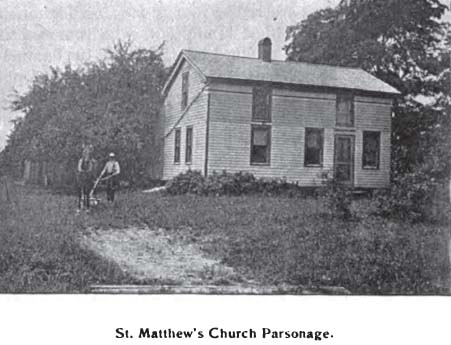
St. Matthew's Parsonage
and Warner Mann. There were twelve scholars in
attendance, the parents paying each his share of the teacher's
salary, which was, undoubtedly, a trifling sum. The first saw
mill was erected in 1809, by Thomas Gordon, on the site
where, afterwards, was located a woolen mill. In the spring of
1831, Emmerson Gibbs put in operation, a carding machine, and
in the fall of the same year, cloth-dressing machinery. The
next season, a mill for grinding corn, was placed in the same
building. In 1839 this site was purchased by Messrs. Hubbel
and Kenney, and a woolen factory, of one hundred and eighty
spindles, established. This was destroyed by fire on the night
of Dec. 24, 1847. The first frame house was built by
Captain Moses Hall, on the northwest corner lot, and the first
frame school house was erected in the spring of 1817, by
subscription; its location was some three quarters of a mile north
of the Center (known as the Chapel).
The first church organization, was that of the
Episcopal denomination. However, services were held by all
denominations, from the time of the first settlements, at the houses
of the settlers, and at the frame school house, or chapel, mentioned
above. There are now two fine church edifices in the township:
St. Mathew's Episcopal, which is located some half mile east of the
Center, erected in 1841, and the Methodist at the Center, which was
not finished till, perhaps, 1874. The first post office, and,
in fact, the only one in the township, was established June 16,
1846. William Warner Mann was the first postmaster,
serving twelve years. The first store was established in 1849,
by William W. Mann, in a building, then standing between the
school house and the residence of Charles Wright. Mr. Mann
continued in business some ten years in Plymouth, removing first to
East Ashtabula, where he engaged in the mercantile business, for two
years more, and then moved to the corner of Center and Park streets,
Ashtabula. In 1824, and for the five years subsequently, he
was engaged as mail-boy for the "Recorder," published in Ashtabula,
which paper was, probably, the first one published in Ashtabula
County. Peter LaGrange also conducted a store in
Plymouth for some years. Plymouth has been largely devoted to
the manufacture of butter and cheese, principally by individuals.
During the Rebellion, Plymouth sent many of her brave sons to
the front in support of the flag and defense of the integrity of the
nation, having representatives in the "Glorious old Twenty-ninth
Ohio Volunteer Infantry," the "One Hundred and Fifth," the "One
Hundred and Twenty-fifth," "Eleventh New York Battery," and other
organizations. They gave to their State and the Union, their
bravest efforts, and much of their best blood.
Much of the above information has been copied from teh
History of Ashtabula County, and the author is also greatly indebted
to Mrs. Ellen S. Lockwood for other facts presented in this
sketch. Of her own family Mrs. Lockwood writes as
follows: My mother was born in Plymouth, Conn., March 2, 1825,
and here I was born October 17, 1845. My grandmother died July
21, 1860, and my grandfather in March, 1879. The old house is
still owned by my parents and is in a good state of preservation,
the frame apparently as good as ever. My parents celebrated
their golden wedding May 19, 1892."
Mrs. Hannah Maria Graham McNutt, who now keeps
the post office, relates, that in 1820, Harry Graham and wife,
and one child, came to Plymouth, Ohio. Mrs. Graham's
name was Elizabeth Miller, from New York State. Mr.
Graham was born in Philadelphia, and went to Canada. They
both came to Ashtabula at the same time, before they were married,
in a boat owned by him, and located in Plymouth in 1818, two miles
from any inhabitants, in the woods, on the same ground that is now
occupied as a station, on the Jamestown and Franklin Division of the
Lake Shore Railroad. All the goods they had were drawn in on a
hand sled. He payed for his farm by clearing two acres
for one, and had the first crop of wheat. Zadoc Mann,
owned 900 acres of land here, heavily timbered, which he bought for
twenty-five cents an acre. He gave each of his children a
farm, gave ground for a church lot and sold the balance in that way.
All the music they had in those days, was the howling of the wolves,
and the mother's cradle song. They fed the wild turkeys, by
raising the back window and throwing out corn. Mrs. McNutt,
today, cooks diner in the same kettle that her father and mother
brought from Canada, in the boat with them, in 1818.
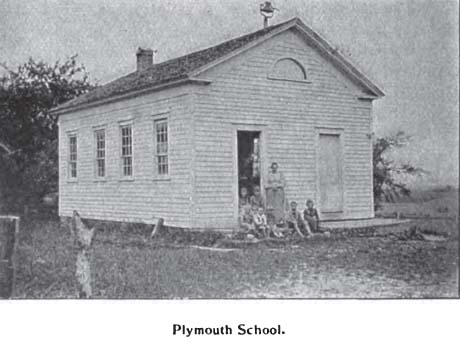
Of the original settlers from Plymouth,
Conn., or their descendants, the following notices have been copied:
WILLIAM WARNER, son of Warner Mann, born
in Ashtabula, Ohio, June 22, 1813, died May 24, 1880. Grandson
of Zadoc.
Elias Cook Upson, born in Waterbury, Conn., Dec.
16, 1797; married Orra, daughter of Bella Blakeslee,
Mar. 31, 1824; died March, 1879. He was a Mason over
fifty-four years, and took charge of the church over forty years,
without pay.
Merrit L. Satterlee, son of Clara Blakeslee
Satterlee, born in Connecticut, went to Chicago in 1836, died
Jan. 28, 1894.
Died in Plymouth, Ohio, Sept. 10, 1894 - Mrs. Clara
Casady, daughter of the late Stephen and Amanda Mann, and
granddaughter of Joseph Mann, wife of Charles Casady,
aged forty-four years.
In Ashtabula, 11th inst. (year unknown), Henry Jude
Blakeslee Seymour, son of Titus Seymour, aged
seventy-three years.
Hon. Andrew W. Mann, son of Warner Mann
(by first wife), born in Plymouth, Ohio, Sept. 4, 1845, and died at
his home, in Burr Oak, Kansas, May 9, 1890. He was a member of
Company C, 29th Ohio Volunteer Infantry, and was transferred from
the Army to the Navy in 1864; served nine months on the monitor,
Winnebego, and three months on the Circassian.
Robert Seymour died Mar. 25, 1875, aged eighty
years. Melissa, his wife, died Feb. 1, 1863, aged
seventy-four years.
Asher Blakesleee died Jun. 4, 1831, aged
sixty years. Charlotte his wife, died May 13, 1818, in
the thirty-seventh year of her age.
Collins Wetmore died July 14, 1859, aged
seventy-two years. Maria Wetmore died Dec. 15, 1880,
aged eighty-four years and six days.
Amanda Mann died Aug. 30, 1853, aged sixty-four
years.
Zadock Mann died Sept. 29, 1846, aged
eighty-seven years. Hannah, his wife, died Jan. 21,
1846, aged seventy-six years.
Esther, his first wife, died July 9,
1825, aged sixty-six years.
Clara Blakeslee Satterlee died Apr. 30, 1874,
aged eighty-two years.
Warner Mann, born Feb. 16, 1784, died May 27,
1858.
Died in Plymouth, Ohio, May 15, 1892, Mrs. Amanda
Mann, the widow of the late Stephen Mann (son of
Joseph), and daughter of Mrs. Clara Blakeslee Satterlee,
aged seventy-one years, two months and nineteen days.
In Plymouth, Ohio, 10th inst. Mrs. Sophia G. Mann,
second widow of Joseph Mann, aged ninety-six years.
Died at McGregor, Iowa, July 19, 1883, Mrs. Amanda
Mann Matthews, wife of Isaac Matthews, and daughter of
Warner Mann She died on her fifty-sixth birthday.
Died in Ashtabula 20th inst., of paralysis, Frances
A., widow of Garwood Blakeslee, aged 69 years.
In Plymouth, O., Feb. 20, Mrs. Olive Lewis,
widow of Wm. Lewis and daughter of Bela Blakeslee,
aged eighty-one years. Mrs. Esther R., his wife, died
Aug. 20, 1865, aged seventy-five years. Emigrated from
Plymouth, Conn., in 1813.
In Plymouth, O., Oct. 11, 1865, Lucy C., wife of
Darius Van Slyke, and daughter of Elias Cook Upson,
aged twenty-nine years; also on the 15th inst., an infant daughter,
aged nine days.
In Plymouth, O., Sept. 30, 1862, Chauncey Blakeslee,
son of John Blakeslee, aged thirty-nine years. Died in
Plymouth, O., Dec. 23, 1880, Mrs. Lucy Blakeslee Ross, a
daughter of John Blakeslee, aged about sixty-five years,
widow of the late Felix Ross.
Died in East Ashtabula, Dec. 15, 1880, Maria Mann,
daughter of Zadoc Mann, and relict of the late Collins
Wetmore, aged eighty-four years.
In East Ashtabula, O., May 30, 1880, Minerva,
wife of Collins E. Mann (son of Joseph), aged
fifty-seven years.
In Ashtabula, O., Oct. 1, 1880, Mrs. Rebecca F. Mann,
the late relict of Wm. Warner Mann, aged seventy-one years
and six months.
In Plymouth, O., Feb. 4, 1884, Mrs. Lucy C. Mann,
wife of Hiram E. Mann, aged sixty-seven years (formerly
Lucy C. Judd of Connecticut.)
Died in Lenox, O., Feb. 13, 1886, Mrs. Helen Harper
Graham, granddaughter of Joseph Mann, and wife of
Joseph Graham.
Died at Independence, Iowa, Oct. 6, 1895, Mr. Cassius
Mann Matthews only son of Isaac and the late Amanda
Mann Matthews, aged fifty-one years.
Died in Plymouth, O., Nov. 5, 1895,
Edgar Orson, son of Orson H. and Mary Mann, aged
thirty-one years. Died in Plymouth, O., Dec. 6, 1895, aged
seventy-seven years, Mrs. Julia Mann Seymour, widow of the late
Wm R. Seymour; she was a daughter of Joseph Mann
and sister of Austin and Orson Mann, of
Plymouth; she was the mother of ten children, seven of whom survive
her.
RE-UNION OF THE DESCENDANTS OF PLYMOUTH, CONN., FAMILIES.
Of the families that went from
Plymouth, Conn., in 1813, there are now some 400 descendants of the
Manns, Blakeslees, and Seymours. It was decided
to hold a re-union of those living June 20, 1895, at Woodland Beach
Park, near Ashtabula, Ohio. It was not as largely attended as
could be wished, on account of the heavy rain which commenced quite
early in the day and continued far into the night, thus making it
impossible for many to get there. A goodly number, however,
were on hand early, and although the rain made it unpleasant in some
respects, the affair as a grand success. There were about 150
or more people present, of which were recorded 119 names of
relatives.
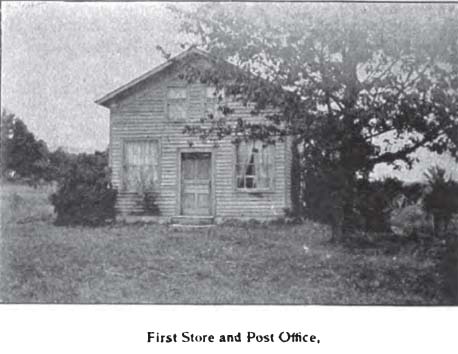
FIRST STORE and POST OFFICE
The occasion was indeed a very pleasant one.
After some time spent in visiting, dinner was served, which was
truly bountiful and excellent. Dinner was followed by a
business meeting, R. O. Rote of Geneva, being chairman of the
meeting, and Francis Atwater of Meriden, Conn., acting as
secretary. After a few brief remarks, the Mann, Blakeslee
and Seymour Re-union Association was duly organized, and the
following officers were elected: President, William Seymour;
vice president, Mrs. Maria Seymour Ticknor; secretary,
Mrs. Ellen S. Mann Lockwood; treasurer, Fred W. Blakeslee.
A committee of three, on date of
next meeting, were elected. After which came the reading of
letters from absent ones.
The first was from Bela Blakeslee Satterlee, of
Plymouth, Conn., containing a goodly number of "Town Orders" given
to different men. Among them were Zadoc Mann, Titus
Seymour, Abel Seymour, Jude Blakeslee, Bela Blakeslee, Asher
Blakeslee, Aaron Dunbar, and others and bearing date from 1793
to 1809, signed by Gen. Daniel Potter, Capt. Oliver Stroughton,
Samuel Blakeslee, Elijah Warner and others, "Selectmen of the
town."
Then came a letter from Isaac Matthews, of
McGregor, Iowa, in which he gave a brief description of the town of
Plymouth, Ohio, from 1835 to 1850, speaking of many of the pioneers
who have passed to the great beyond, but are not forgotten.
A postal card from Mrs. Olive Mann Isbell, was
read, expressing many regrets that she could not attend, sending
congratulations and messages of love to all.
A very excellent letter from Austin W. Buffum of
Tecumseh, Nebraska, in which a desire to be remembered, is earnestly
expressed; also a letter from Mr. and Mrs. George W. Buffum,
with regrets that distance would not allow their attendance.
One from Mrs. Betsey Gordon of Plymouth, Conn. Postal
from Mrs. Emma Satterlee Fuller of Cleveland. A letter
from Mr. Geo. Satterlee of Chicago, in which ill health
prevented attendance. Letters from L. W. and John H. Mann
of Ocala, Fla., with best wishes to all. A letter from Mrs.
Eleanor Paine was noticed, wishing to know if Milton Phelps
was yet alive.
Others were from Carlos A. Mann, of Portland,
Oregon, and Mr. Henry Seymour of Waupacca, Wis., all of which
tell of the love that binds us together in kindred affection.
Those present were:
Mrs. Ellen S. Mann Lockwood, Plymouth, Ohio
Mrs. Frankie Mann Warner and one child, Mr.
Wilber Warner, Mrs. O. H. Mann, Orson H. Mann, son of Joseph,
Mrs. Edgar O. Mann, and two children, Edgar O. Mann,
grandson of Joseph, Plymouth, O.
Mr. and Mrs. O. Perry Mann, son of Merrit,
Miss Flora M. Mann, Frank L. Mann, Charles T. Mann, Earl T.
Mann, Plymouth, O.
James L. Flint, 221 West Prospect street,
Ashtabula, O.; Mrs. Esther Mann Flint, daughter of B. P.
Mann; George Porteus Flint, Estella M. Flint, Sarah Flint,
James Beilby Flint.
Milan M. Seymour, Walter Seymour, 276
Euclid avenue, grandchildren of Wm. R. Seymour, Cleveland, O.
Merrick J. Seymour, son of Wm. R.
Seyour; Mrs. Harriet Blakeslee Seymour, daughter of L. P.
Blakeslee, John Mann Seymour, William Merrick Seymour, Plymouth,
O.
Miss Lucy E. Topper, Ford Porteus Topper,
grandchildren of B. Porteus Mann, East Plymouth, O.
Mrs. Mary Castle Fulkerson, daughter of
Electa Mann Castle, and granddaughter of Joseph Mann, and
daughter, Mrs. Adell Fulkerson Smith, D. S. Fulkerson,
Geneva, O.
Fred W. Blakeslee, son of Garwood Blakeslee,
Mrs. Fred W. Blakeslee, and two sons, Ashtabula, O.
Norman Colby and child, Mrs. Estella Amidon
Colby, daughter of Emily Seymour Amidon, daughter of
Julia Seymour, daughter of Joseph Mann. H. C. DeGroodt,
and Mrs. Mattie Amidon Degroodt, Chauncey Amidon and son,
Moses. Mrs. Emily Seymour Amidon, Ashtabula, O.
Austin W. Mann, son of Joseph Mann,
Ashtabula, O.
Frank E. Harmon and wife, Mrs. Emeline
Seymour Hrmon, who great grandfather was Zadoc,
grandfather Warner, on her mother's side; her mother was
Sevea Mann, her grandmother was Amanda Mann, wife of
Warner, and daughter of Bela Blakeslee, and granddaughter
of Jude. Mrs. Harmon's father was Bennett, son of
Titus Seymour, and his mother was Sevea Blakeslee; so she
is directly related to all three families - Manns, Blakeslees
and Seymours.
James White, whose mother was Fannie,
daughter of Zadoc Mann, had with him his daughter and one
child; her name as Lucy White Harvey.
Mrs. Hobart Blakeslee, (Hobart, son of John),
Miss Lucy Blakeslee, Charles Blakeslee, Mrs. Charles Blakeslee,
Ashtabula, O.
William Seymour (son of Robert), Mrs.
William Seymour, Ashtabula, O.
Frank Harper, son of Loyd Mann Harper,
son of Betsy Mann Harper, daughter of Joseph, East
Plymouth, O.
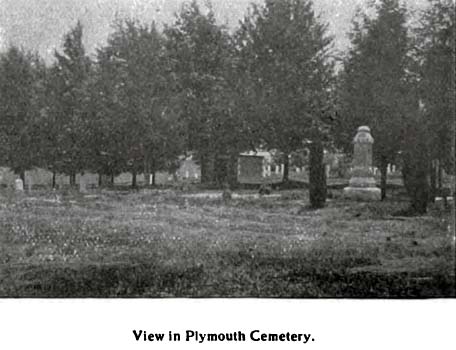
Allen H. Morgan, son of Julia Mann
Morgan, daughter of Wm. Warner Mann; Mrs. Hattie Morgan
and children - Grace, Tommy, Hazel, Jasper, Howard, Morgan -
East Plymouth, O.
Mrs. Julia Blair, granddaughter of Henry Jude
Blakeslee Seyour, Ashtabula, O.
Oliver Perry, Clayton Perry, Mrs. Flora Ticknor
Perry, daughter of Maria Seymour Ticknor, Grigg's
Corners, O.
Miss Mae Mann daughter of
Watson E. Mann,
son of Beilby Porteus Mann, son of Warner, son of
Zadoc, Ashtabula, O.
Kate Seymour, Alice Seymour, Clarence Seymour,
children of Rev. Edward Seymour, supposed to be relatives -
cannot trace readily.
Elder Edwin Dibell, claims distant relationship
to one of Great Grandfather Zadoc Mann's wives, Kingsville,
O.
Frank E. Mann, son of Austin, son of
Joseph, Plymouth, O.; Wilfred M. Mann, son of Austin,
son of Joseph; Mrs. Mira I. Mann, wife of Wilfred, and
daughter of Beilby Porteus Mann, and children - Grace
Minerva, Ethel Lorena, George Kenneth Mann - East Plymouth, O.
Frank Layton Pancost, grandson of B. P. Mann,
and so of Ellen Mann Pancost Lockwood; Alice Cary Lockwood,
daughter of Ellen S. Lockwood, East Plymouth, O.
Mrs. Maria Seymour Ticknor, wife of Edmund
Ticknor, and daughter of Henry Jude Blakeslee Seymour and
granddaughter of Titus Seymour, Maria Mann Wetmore, and
Miss Louise Elida Ticknor, Grigg's Corners, Ashtabula, O.
Mr. and Mrs. Isaac Hine, daughter of H. J. B.
Seymour, James Hine, Zoe Hine, Huber Hine, Ashtabula, O.
Mr. and Mrs. F. B. Ashley, and
child, North Richmond, Ashtabula County, O.
Mrs. Louise Harmon Dickson, (granddaughter of
Bennet Seymour, daughter of Emeline Seymour Harmon), and
baby, Dorothy Dickson, Charles Clare Dickson, Ashtabula, O.
Beilby Porteus Mann, John Henry Mann (sons of
Warner Mann and grandsons of Zadoc), Plymouth, O.
John Josiah Morgan (sonof Julia Mann Morgan),
East Plymouth, O.
Reuben Hall (son of Lucy Seymour Hall,
daughter of Ziba Seymour, brother of Titus Seymour),
Dover, O. James Hall, 1110 Bloomfield street, Hoboken,
New Jersey.
Byron Mann, Mrs. Charlotte Mann and daughter of
Jessie Adella Mann, Cherry Valley, Ashtabula County, O.
Solomon Phillips, Mrs. Eva Robinson,
(daughter of Ruth Mann Phillips, daughter of Warner Mann
by second wife), and Gertrude Mann Robinson, Akron, O.
Francis Atwater, Meriden, Conn.
L. L. Blakeslee and wife, S. E. Blakeslee
and wife, J. A. Blakeslee and wife, Mr. Paden and
wife, Mr. Perine, Colebrook, Ashtabula, O.
THE FIRST AMERICAN TEACHER IN CALIFORNIA.
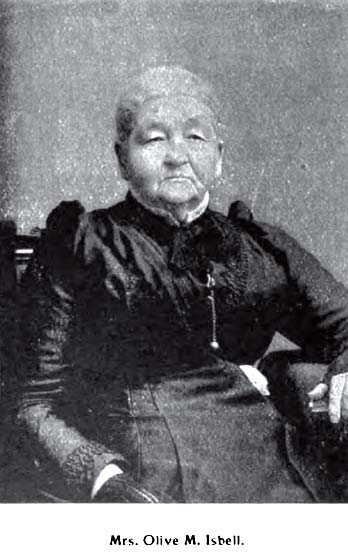
MRS. OLIVE M. ISBELL
Mrs. Olive Mann Isbell, now living in
Santa Paula, Ventura county, was one of the earliest pioneers, and
teacher of the first American school in California. She went
from Plymouth, Ohio.
October 1, 1846, an emigrant train of twenty-one wagons
- escorted by Col. John C. Fremont and a detachment of
soldiers who had met them at Johnson's ranch - arrived at
Sutter's Fort. Capt. Sutter welcomed them with
characteristic cordialty, and did everything possible for their
comfort. This company, commanded by Capt. John Aram and
Dr. I. C. Isbell, had left Illinois, in April, for California,
with no definite knowledge of its location, except that it was
somewhere on the Pacific Coast. They had made their pathless
way over plains, desert and mountains. By some mischance they
failed to meet the Donner party at the Mississippi; passed them at
Gravelly Ford; left them there in a quarrel - and thus narrowly
escaped their tragic fate. At Fort Hall they learned from
panic-stricken refugees returning to the States that war with Mexico
had been declared. A council was called to decide whether they
should go forward or back. Women cried and begged to be taken
home; men were divided in opinion. "What shall we do, Olive?
said Dr. Isbell. The stout-hearted matron of twenty-two
replied. "I started for California, and I want to go on." That
settled it. Others took heart, and the train went on
undivided. After resting a week at Sutter's Fort, under orders
from Fremont, they proceeded to the Santa Clara Mission, 150
miles south, and reached it October 16. The old adobe building
of the Mission was not an inviting shelter to the homesick
immigrants, if shelter it could be called at all. There were
no floors but the hard-baked earth, no windows, no fire-places, no
escape for smoke, save a hole in the roof. The ancient walls
were infested, and the crumbling tiles let the rain through almost
as copiously as it fell outside. The section assigned them had
been previously used for stabling horses.
Col. Fremont left a few men to protect the women
and children, and took all the able bodied to re-inforce his small
army, preparing to move southward to join Stockton at San Diego.
Dr. Isbell enlisted as surgeon, and went as for as the
Salinas river. Here he was seized with "emigrant fever"
(typhoid pneumonia), which compelled his return to the Mission,
where by that time the fever had become epidemic. The rains
came early that year, with strong southwest winds. There was
no physician nearer than St. Jose, and he to be had but once a week.
From their well stocked medicine chest Mrs. Isbell
distributed on an average one hundred doses of medicines a day, and
for six weeks slept in a chair by her sick husband's side.
They were in any enemy's country, expecting daily to be attacked.
Indications of treachery led them to send a messenger to Capt.
Webber and San Jose for additional protection. He in turn
sent to Yerba Buena for Capt. Marsten with a company of
twenty-five marines and one cannon drawn on an ox-cart. The
first intimation the immigrants had that help was near was the
report of firearms in the distance. Climbing on the wall they
saw the soldiers trying to pull the cannon out of the mud, while the
natives, concealed in the chaparral, were firing at them.
Capt. Marsten rode up and asked the loan of a white cloth for a
flag of truce; and Mrs. Isbell gave her wedding pocket
handkerchief for the purpose.
In this skirmish two soldiers were wounded: one in the
fleshy part of the leg, the other in the head. Mrs. Isbell
and Mrs. Aram dressed the wounds and prepared dinner for the
hungry soldiers. This was the much disputed battle of
"Santa Clara," as seen by an eye witness. Mrs.
Isbell had spent several nights in cleaning firearms and running
bullets- determined, if attached, to aid in the defense.
Another company of soldiers from Santa Cruz arrived soon after.
The winter was marked by unusual cold and over-abundant
rains, and tested the endurance of the settlers. Four at $8 a
barrel was beyound their slender purses, so they subsisted on
government rations, glad to be saved from starvation. The few
who kept well were taxed beyond their strength in ministering to the
sick, and many died under distressing conditions.
Near the end of December Mrs. Isbell was
persuaded to open a school. A room fifteen feet square, too
dilapidated for any other purpose, was obtained. It was damp,
dark and dirty; and after suffering several days with eyes smarting
from smoke, they were obliged to forego the luxury of fire.
The school supplies were limited to a few textbooks, brought by the
various families. A daughter of Capt. Aram, now living
in Los Angeles, says she remembers distinctly her struggles with the
letter E. For want of black-board, slates or paper, the
teacher printed it on the back of her hand with a led pencil.
There were twenty-five pupils and the term continued two months.
It was the first American school in the State.
In the Spring of '47 Dr. Isbell and wife went to
Monterey, where she was induced to resume her work. The school
opened with twenty-five scholars, but soon increased to fifty-six.
At the close of the term, three months, the teacher left the
school-room for ranch life at French Camp.
|